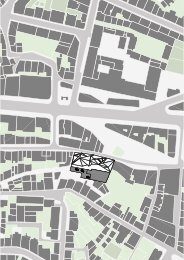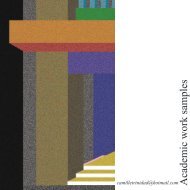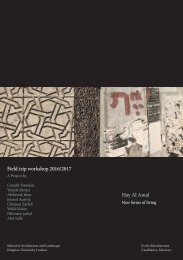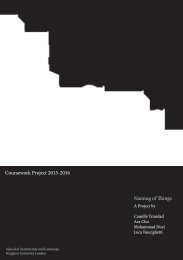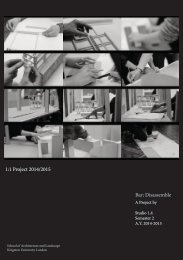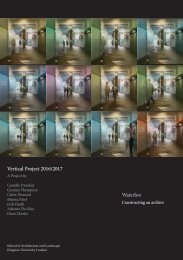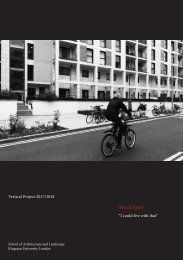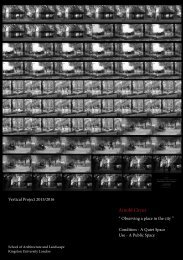National Theatre of the Philippines
My final year dissertation which explored a symbolic edifice in Manila, built by the National Artist for Architecture as per request of the former First Lady of the Philippines. It discusses Architecture's innate role in a political society, specifically in a country that has undergone centuries of colonialism; which got an overall grade of A.
My final year dissertation which explored a symbolic edifice in Manila, built by the National Artist for Architecture as per request of the former First Lady of the Philippines. It discusses Architecture's innate role in a political society, specifically in a country that has undergone centuries of colonialism; which got an overall grade of A.
Create successful ePaper yourself
Turn your PDF publications into a flip-book with our unique Google optimized e-Paper software.
This is a trend during <strong>the</strong> Cold War period (1950-91); <strong>the</strong>re were exportation <strong>of</strong><br />
architectural ideas, practices, pr<strong>of</strong>essionals and in some cases whole buildings were a<br />
popular way <strong>of</strong> modernising and controlling o<strong>the</strong>r nations. USA was primarily<br />
concerned with exporting ideas and <strong>the</strong>ories. They saw architecture as a means <strong>of</strong><br />
modernisation for <strong>the</strong> developing nations. It was thought that by increasing <strong>the</strong> standard<br />
<strong>of</strong> living and introducing <strong>the</strong> American ideals <strong>of</strong> family, anti-communism, individualism<br />
and democracy, <strong>the</strong>se nations would be swayed away from joining <strong>the</strong> Soviet Union.<br />
The U.S. government identified strategic locations for construction projects and<br />
provided funds ei<strong>the</strong>r directly or through agencies, however <strong>the</strong>y were not directly<br />
responsible for carrying out any <strong>of</strong> <strong>the</strong> projects. The task <strong>of</strong> running <strong>the</strong> projects was left<br />
to a group <strong>of</strong> non-government organisations, philanthropic foundations, aid<br />
organisations, corporations and individual pr<strong>of</strong>essionals who designed and oversaw <strong>the</strong><br />
projects.<br />
35<br />
The Marcos regime saw this opportunity and took all <strong>the</strong> chances to gain longevity in<br />
his presidential term through building structures. How this conjugal dictatorship sees<br />
<strong>the</strong> new society was parallel as to how <strong>the</strong> Stalinist and Nazi Architecture were<br />
perceived. One <strong>of</strong> <strong>the</strong> reasons why Architecture has been used as a representation <strong>of</strong><br />
power over <strong>the</strong> society is that a structure can last a thousand years and will become a<br />
part <strong>of</strong> that civilisation’s history. When <strong>the</strong> Nazi lost, <strong>the</strong>re were plans in keeping some<br />
buildings that Adolf Hitler has built against <strong>the</strong> public outcry <strong>of</strong> <strong>the</strong> victims during his<br />
regime. This is because, as much as that evokes anguish and such nostalgia, it has<br />
already been a part <strong>of</strong> <strong>the</strong> history <strong>of</strong> that city. It has already left a mark in <strong>the</strong>ir history,<br />
culture and tradition. That would always be a part <strong>of</strong> <strong>the</strong>ir identity. 36<br />
35 Faulks, Michael, Who <strong>the</strong>...? The Exporters <strong>of</strong> Architecture During <strong>the</strong> Cold War (2014) https://www.researchgate.net/publication/<br />
273381518_Who_<strong>the</strong>_The_Exporters_<strong>of</strong>_Architecture_During_<strong>the</strong>_Cold_War (accessed 18 July 2017)<br />
36 Sudjic, Deyan. The edifice complex: how <strong>the</strong> rich and powerful shape <strong>the</strong> world, London: Penguin, 2006<br />
!46






